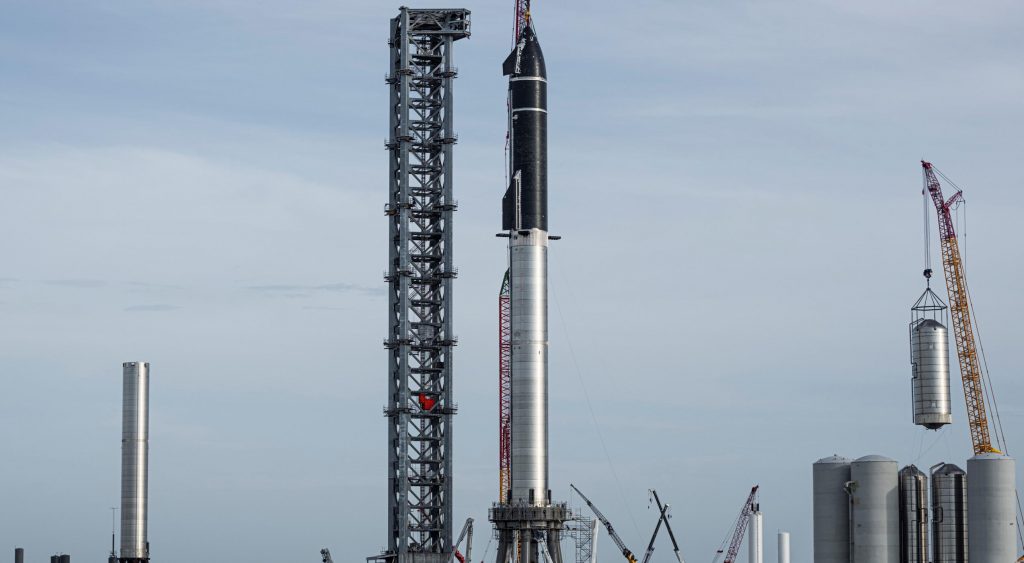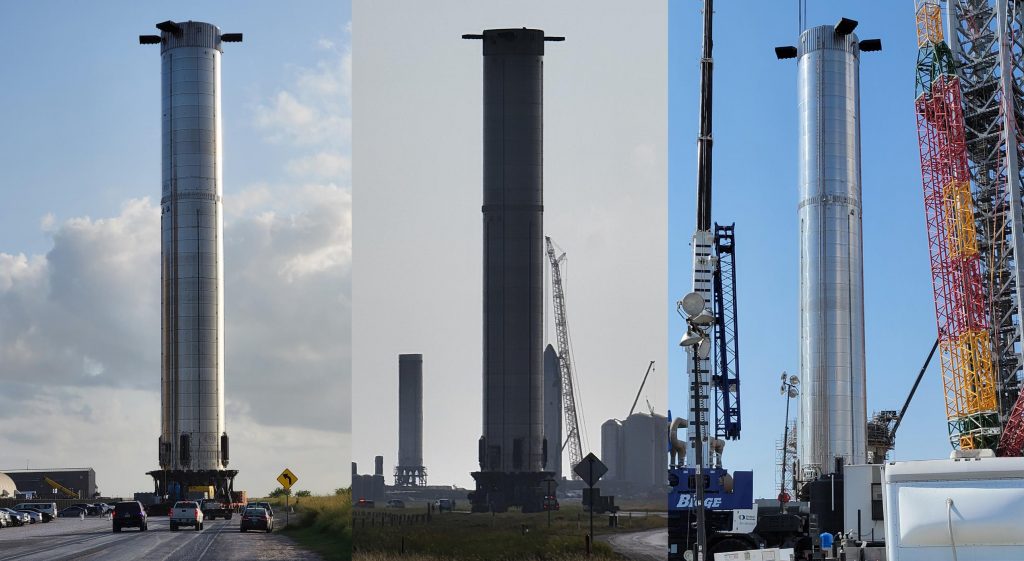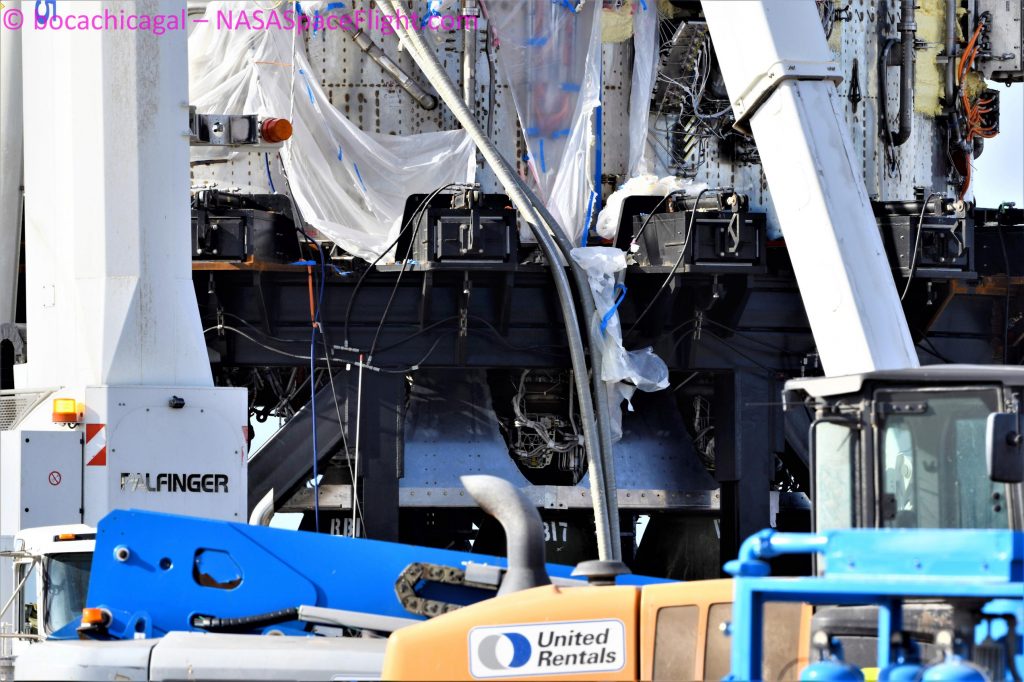

News
SpaceX preparing Super Heavy, Starbase for booster’s next steps
Amid a flurry of deliveries and work on several new Starship boosters, SpaceX is preparing the first truly finished Super Heavy for its next steps.
Partially completed by early September, Super Heavy Booster 4 (B4) supported SpaceX’s iconic ‘full stack’ fit test back on August 6th before returning to the build site but has mostly just floated around Starbase’s launch and test facilities in the seven weeks since its second trip to the pad. On September 10th, CEO Elon Musk himself suggested that SpaceX had plans to static fire the booster as early as mid-September – more than six weeks ago. Obviously, nothing even approximating Super Heavy testing transpired. Instead, at least relative to rapid-fire Starbase operations in the two years prior, SpaceX has almost absentmindedly worked on the booster, mostly completing partially-finished wire runs that run its full 69m (~225 ft) length.
In the last few weeks, though, the type of work being done on Super Heavy B4 has changed.



On September 26th, to give the Starbase construction crew more room to install giant arms on the orbital pad’s ‘launch tower,’ SpaceX removed Super Heavy B4 from the launch mount for the second time, temporarily relocating it to an unused patch of the pad’s old landing zone. Booster 4 hasn’t been moved since. However, while probably a bit slower than SpaceX would have liked, large-scale work on the Starship launch tower was effectively completed last week with the installation of two giant rocket-catching ‘Mechazilla’ arms.
A great deal of work has also been done on Starbase’s orbital tank farm over the last two months, including the installation of the last few storage tanks, the ‘sleeving’ of those tanks, a great deal of plumbing, and the start of real propellant deliveries. Save for a few days spent testing Starship S20 in late September and mid-October, the pad construction crews that have to evacuate the pad for 6-12 hours for every test have had three full months to work without interruption. Perhaps the most optimistic explanation for the unusually long gap between Booster 4 and Ship 20 rollout and testing is that SpaceX consciously chose to put off vehicle tests to avoid disrupting orbital launch site construction and retasked nearly all Starbase workers for that construction.
Regardless, with the launch tower and orbital tank farm now more or less structurally complete and work already underway to prepare the tank farm to support its first booster tests, most of the work that may have been drawing focus and resources away from ship and booster preparations appears to be wrapping up. That may be why, for the third time, SpaceX technicians began removing a number of Raptor engines from Super Heavy B4 around the start of October.
Aside from removing around a third to half of Super Heavy’s 29 Raptors, SpaceX also began slowly but surely installing parts of a steel heatshield designed to protect those engines during ground testing, ascent, and reentry. Newer Raptors have also been trickling from Starbase’s build site to the launch pad for installation on the booster and more engines will likely be (re)installed as heatshield installation progresses.

Perhaps the most unusual part of recent Super Heavy B4 work is the apparent application of some kind of foam around several racks of pressure vessels (COPVs), hydraulic manifolds, and umbilical connections installed around the booster’s base. Those racks will eventually be enclosed inside steel ‘aerocovers’ already staged beside Super Heavy. A number of Twitter users believe that the foam being selectively applied is for acoustic deadening – meant to protect sensitive electronics, valves, and computers from the brutal environment Super Heavy itself will produce at liftoff and during ground testing.
Ultimately, with Booster 4 work ramping back up and the zenith of orbital pad construction activity now likely behind SpaceX, preparations for major Super Heavy testing will hopefully resume. SpaceX has yet to perform a full Super Heavy wet dress rehearsal (WDR; fully filling a rocket’s tanks and performing a launch countdown) or fire up more than three Raptors on a booster or ship prototype. With any luck, that will finally change in the final months of 2021.
News
Tesla cleared in Canada EV rebate investigation
Tesla has been cleared in an investigation into the company’s staggering number of EV rebate claims in Canada in January.

Canadian officials have cleared Tesla following an investigation into a large number of claims submitted to the country’s electric vehicle (EV) rebates earlier this year.
Transport Canada has ruled that there was no evidence of fraud after Tesla submitted 8,653 EV rebate claims for the country’s Incentives for Zero-Emission Vehicles (iZEV) program, as detailed in a report on Friday from The Globe and Mail. Despite the huge number of claims, Canadian authorities have found that the figure represented vehicles that had been delivered prior to the submission deadline for the program.
According to Transport Minister Chrystia Freeland, the claims “were determined to legitimately represent cars sold before January 12,” which was the final day for OEMs to submit these claims before the government suspended the program.
Upon initial reporting of the Tesla claims submitted in January, it was estimated that they were valued at around $43 million. In March, Freeland and Transport Canada opened the investigation into Tesla, noting that they would be freezing the rebate payments until the claims were found to be valid.
READ MORE ON ELECTRIC VEHICLES: EVs getting cleaner more quickly than expected in Europe: study
Huw Williams, Canadian Automobile Dealers Association Public Affairs Director, accepted the results of the investigation, while also questioning how Tesla knew to submit the claims that weekend, just before the program ran out.
“I think there’s a larger question as to how Tesla knew to run those through on that weekend,” Williams said. “It doesn’t appear to me that we have an investigation into any communication between Transport Canada and Tesla, between officials who may have shared information inappropriately.”
Tesla sales have been down in Canada for the first half of this year, amidst turmoil between the country and the Trump administration’s tariffs. Although Elon Musk has since stepped back from his role with the administration, a number of companies and officials in Canada were calling for a boycott of Tesla’s vehicles earlier this year, due in part to his association with Trump.
News
Tesla Semis to get 18 new Megachargers at this PepsiCo plant
PepsiCo is set to add more Tesla Semi Megachargers, this time at a facility in North Carolina.

Tesla partner PepsiCo is set to build new Semi charging stations at one of its manufacturing sites, as revealed in new permitting plans shared this week.
On Friday, Tesla charging station scout MarcoRP shared plans on X for 18 Semi Megacharging stalls at PepsiCo’s facility in Charlotte, North Carolina, coming as the latest update plans for the company’s increasingly electrified fleet. The stalls are set to be built side by side, along with three Tesla Megapack grid-scale battery systems.
The plans also note the faster charging speeds for the chargers, which can charge the Class 8 Semi at speeds of up to 1MW. Tesla says that the speed can charge the Semi back to roughly 70 percent in around 30 minutes.
You can see the site plans for the PepsiCo North Carolina Megacharger below.

Credit: PepsiCo (via MarcoRPi1 on X)

Credit: PepsiCo (via MarcoRPi1 on X)
READ MORE ON THE TESLA SEMI: Tesla to build Semi Megacharger station in Southern California
PepsiCo’s Tesla Semi fleet, other Megachargers, and initial tests and deliveries
PepsiCo was the first external customer to take delivery of Tesla’s Semis back in 2023, starting with just an initial order of 15. Since then, the company has continued to expand the fleet, recently taking delivery of an additional 50 units in California. The PepsiCo fleet was up to around 86 units as of last year, according to statements from Semi Senior Manager Dan Priestley.
Additionally, the company has similar Megachargers at its facilities in Modesto, Sacramento, and Fresno, California, and Tesla also submitted plans for approval to build 12 new Megacharging stalls in Los Angeles County.
Over the past couple of years, Tesla has also been delivering the electric Class 8 units to a number of other companies for pilot programs, and Priestley shared some results from PepsiCo’s initial Semi tests last year. Notably, the executive spoke with a handful of PepsiCo workers who said they really liked the Semi and wouldn’t plan on going back to diesel trucks.
The company is also nearing completion of a higher-volume Semi plant at its Gigafactory in Nevada, which is expected to eventually have an annual production capacity of 50,000 Semi units.
Tesla executive teases plan to further electrify supply chain
News
Tesla sales soar in Norway with new Model Y leading the charge
Tesla recorded a 54% year-over-year jump in new vehicle registrations in June.

Tesla is seeing strong momentum in Norway, with sales of the new Model Y helping the company maintain dominance in one of the world’s most electric vehicle-friendly markets.
Model Y upgrades and consumer preferences
According to the Norwegian Road Federation (OFV), Tesla recorded a 54% year-over-year jump in new vehicle registrations in June. The Model Y led the charge, posting a 115% increase compared to the same period last year. Tesla Norway’s growth was even more notable in May, with sales surging a whopping 213%, as noted in a CNBC report.
Christina Bu, secretary general of the Norwegian EV Association (NEVA), stated that Tesla’s strong market performance was partly due to the updated Model Y, which is really just a good car, period.
“I think it just has to do with the fact that they deliver a car which has quite a lot of value for money and is what Norwegians need. What Norwegians need, a large luggage space, all wheel drive, and a tow hitch, high ground clearance as well. In addition, quite good digital solutions which people have gotten used to, and also a charging network,” she said.
Tesla in Europe
Tesla’s success in Norway is supported by long-standing government incentives for EV adoption, including exemptions from VAT, road toll discounts, and access to bus lanes. Public and home charging infrastructure is also widely available, making the EV ownership experience in the country very convenient.
Tesla’s performance in Europe is still a mixed bag, with markets like Germany and France still seeing declines in recent months. In areas such as Norway, Spain, and Portugal, however, Tesla’s new car registrations are rising. Spain’s sales rose 61% and Portugal’s sales rose 7% last month. This suggests that regional demand may be stabilizing or rebounding in pockets of Europe.
-

 Elon Musk2 weeks ago
Elon Musk2 weeks agoTesla investors will be shocked by Jim Cramer’s latest assessment
-

 Elon Musk2 days ago
Elon Musk2 days agoxAI launches Grok 4 with new $300/month SuperGrok Heavy subscription
-

 Elon Musk4 days ago
Elon Musk4 days agoElon Musk confirms Grok 4 launch on July 9 with livestream event
-

 News1 week ago
News1 week agoTesla Model 3 ranks as the safest new car in Europe for 2025, per Euro NCAP tests
-

 Elon Musk2 weeks ago
Elon Musk2 weeks agoA Tesla just delivered itself to a customer autonomously, Elon Musk confirms
-

 Elon Musk1 week ago
Elon Musk1 week agoxAI’s Memphis data center receives air permit despite community criticism
-

 News2 weeks ago
News2 weeks agoXiaomi CEO congratulates Tesla on first FSD delivery: “We have to continue learning!”
-

 News2 weeks ago
News2 weeks agoTesla sees explosive sales growth in UK, Spain, and Netherlands in June

















